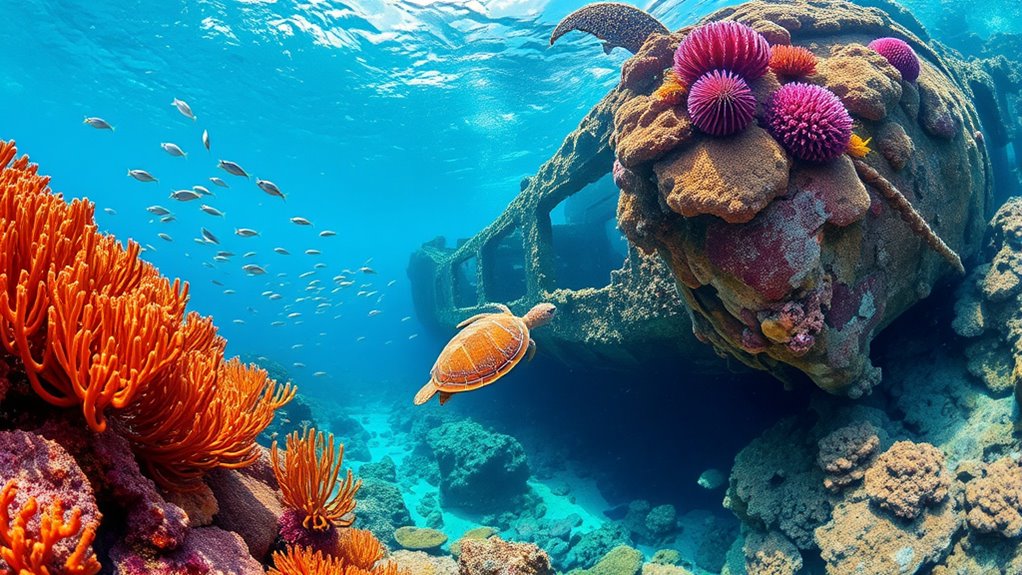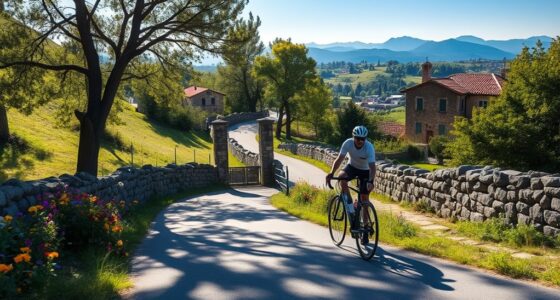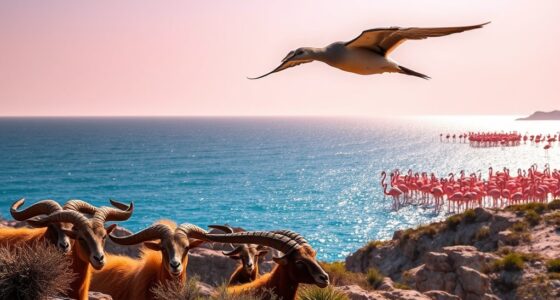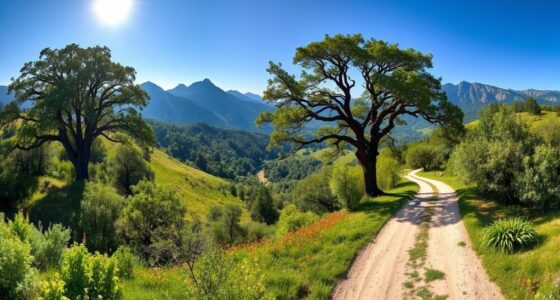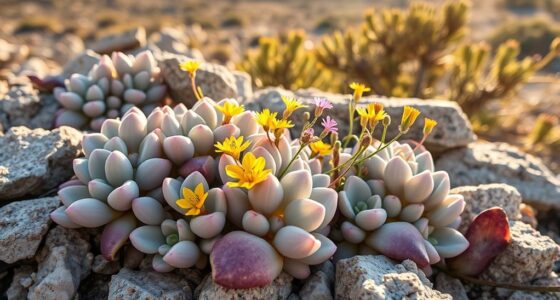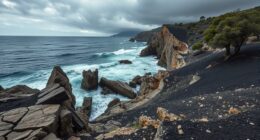Sardinia offers incredible diving spots for all skill levels, from the crystal-clear waters of Capo Testa with caves, reefs, and wrecks, to the underwater caves and historical wrecks of Orosei Gulf. You can explore vibrant marine ecosystems in Villasimius and Capo Carbonara, discover spectacular caves and coral formations in Alghero, and immerse in WWII and ancient Roman wrecks in the Gulf of Cagliari. If you want to uncover these underwater treasures, there’s plenty more to explore.
Key Takeaways
- Capo Testa offers granite formations, caves, wrecks, and rich marine biodiversity in a protected marine area.
- Orosei Gulf features underwater caves, colorful coral walls, and WWII wrecks suitable for experienced divers.
- Alghero is renowned for spectacular caves, Roman shipwrecks, and vibrant red coral colonies.
- Capo Carbonara and Villasimius provide crystal-clear waters, vibrant ecosystems, and accessible dive sites for all levels.
- The Gulf of Cagliari hosts historic wrecks, marine habitats, and diverse marine species in protected waters.
Capo Testa: A Jewel for All Levels of Divers
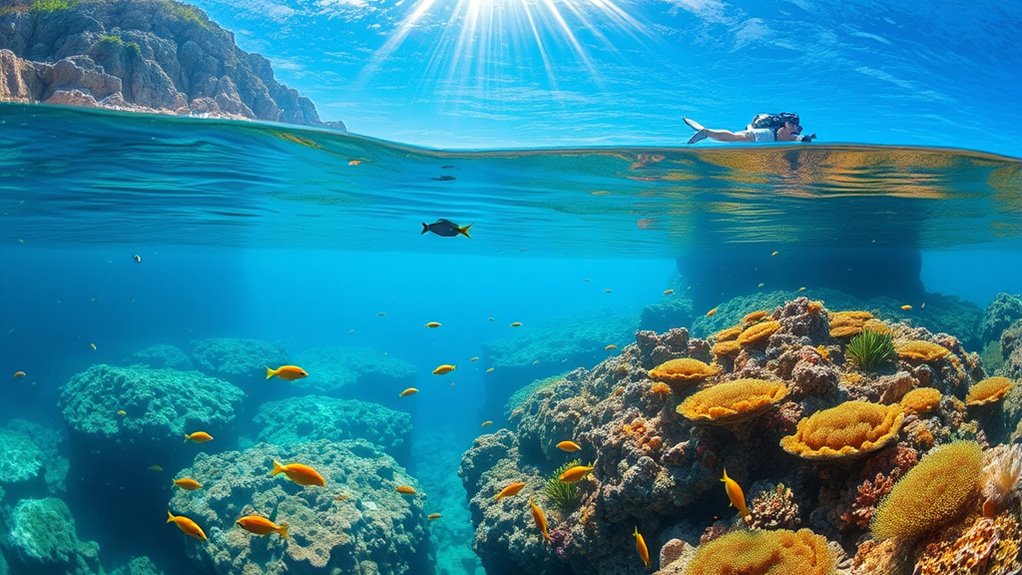
Nestled in the northern part of Sardinia on the Maddalena Archipelago peninsula, Capo Testa stands out as a top destination for divers of all skill levels. You can reach the dive spots easily by boat from local centers in about 15 minutes. The area features stunning granite formations and protected marine zones, including the Marine Protected Area of Capo Testa and Punta Falcone. The waters here are calm, with gentle currents, making it ideal for beginners and experienced divers alike. Visibility often reaches up to 50 meters, providing vibrant views of red gorgonians, corals, and marine life like eels, lobsters, and turtles. The underwater landscape includes caves, reefs, and wrecks, offering diverse exploration opportunities in safe, pristine conditions. Capo Testa is protected by regulations that help preserve its rich marine biodiversity. Additionally, the local dive centers provide guided tours and diving safety protocols to ensure a secure experience for all visitors.
Exploring the Wonders of Orosei Gulf’s Underwater Caves and Wrecks
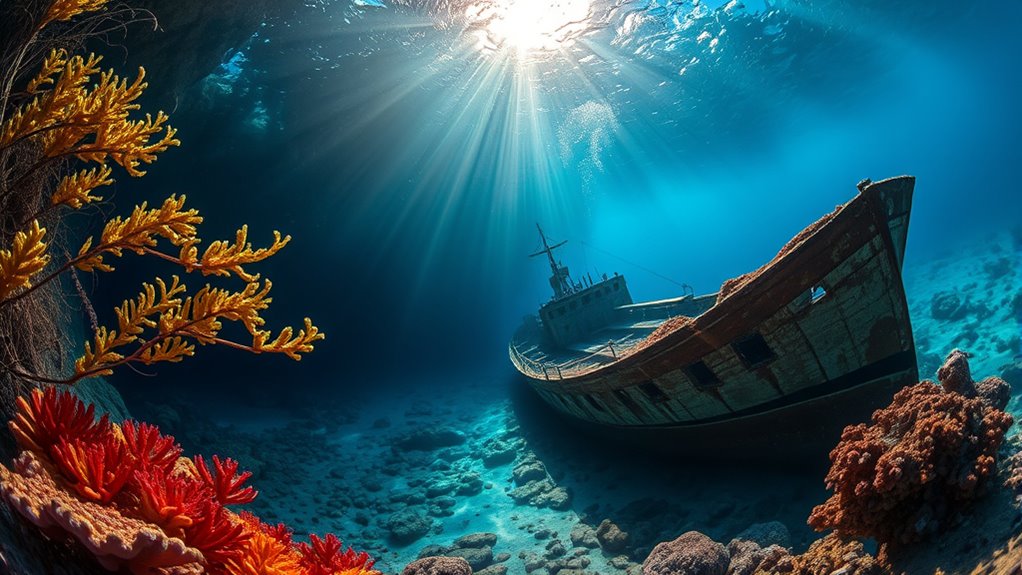
The Orosei Gulf offers an extraordinary underwater landscape that beckons adventurous divers to explore its caves and wrecks. Its underwater caves, like Grotta del Bue Marino and Grotta della Cattedrale, showcase stunning formations, colorful coral walls, and emerald waters. These caves are part of a vast karst system extending over 70 km, with over 400 caves connected to groundwater systems. Discovered in the 1950s by fishermen and shepherds guiding tourists, marine life thrives here, with lobsters, groupers, sea daisies, and vibrant sea fans covering boulders and reefs, especially around Secca di Levante. Wrecks, such as the Wall of Scala di Ferro near Cala Biriola, reveal historical artifacts at depths around 34 meters. Access typically requires advanced skills, making these sites a thrilling challenge for experienced divers seeking both geological wonder and underwater biodiversity.
Capo Carbonara & Villasimius: Ideal Spots for Beginner and Advanced Divers
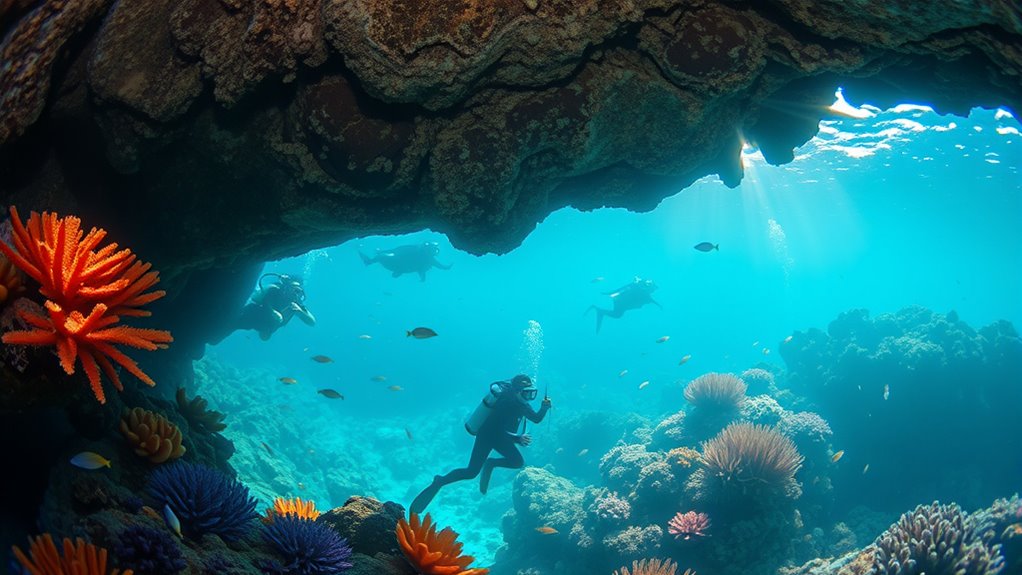
Capo Carbonara and Villasimius stand out as premier diving destinations in Sardinia, offering experiences suited for both beginners and advanced divers. Their crystal-clear waters and protected status create ideal conditions for exploring vibrant marine life and stunning underwater landscapes. Whether you’re new to diving or an expert, you’ll find suitable sites and guided excursions. Includes guided dives with qualified instructors, ensuring safety and enhancing the overall experience. Additionally, the area’s marine conservation efforts help preserve the underwater environment for future divers.
Here are three reasons why you’ll love diving here:
- Diverse dive sites tailored to skill levels, from calm meadows to complex rock formations.
- Rich biodiversity, including barracudas, octopuses, and colorful gorgonians.
- Professional guides and small groups ensure safety and personalized experiences.
Diving in Alghero: Spectacular Caves and Historical Wrecks
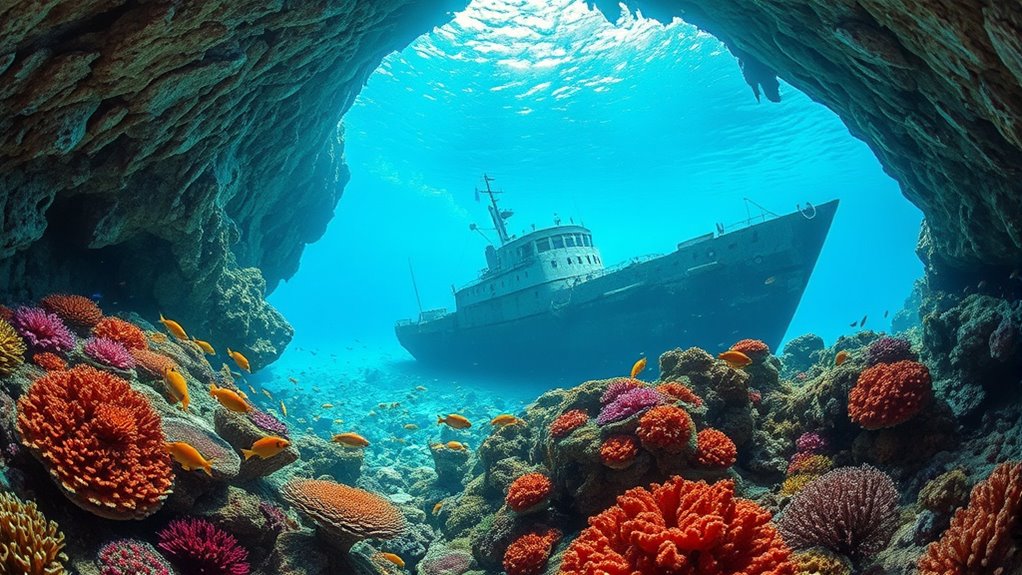
Diving in Alghero offers an extraordinary experience, with its spectacular underwater caves and historical wrecks revealing the region’s rich geological and maritime heritage. You’ll explore towering limestone cliffs that plunge into the sea, creating dramatic topography filled with caves. Over a dozen underwater caves lie within a mile west of the diving center, ranging from shallow, beginner-friendly sites to deep, complex passages for experienced divers. Highlights include Nereo’s Cave, known for its size and stunning formations, and Deer Cave, which houses a 100,000-year-old fossil. Alongside these caves, you’ll encounter wrecks of Roman ships and galleons, many within easy reach from shore. The area’s vibrant red coral colonies and diverse marine life, including seahorses, add to the region’s underwater allure. This region is also renowned for its crystal-clear waters, making it ideal for underwater visibility and photography.
Wreck Sites of the Gulf of Cagliari: History Beneath the Waves
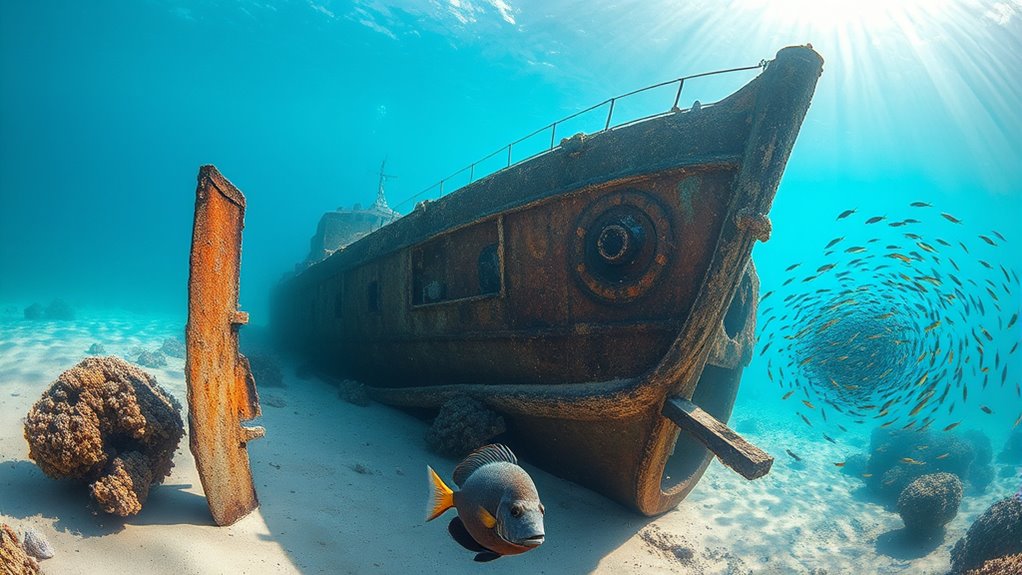
Exploring the underwater wrecks of the Gulf of Cagliari reveals a fascinating layer of maritime history shaped by centuries of conflict and strategic importance. You’ll discover WWII-era ships that tell stories of naval battles and shifting control.
Here are three highlights:
- The MV Loredan, an Italian escort sunk in 1943, lies at 52-67 meters, offering a glimpse into wartime naval operations.
- The Egle cargo steamship, torpedoed by a Dutch submarine in 1943, rests at 30-38 meters, with its hull encrusted in marine growth.
- Wrecks like these serve as artificial reefs, supporting diverse marine life such as groupers, gorgonians, and algae. The wreck of the Loredan is particularly notable for its well-preserved structure and historical significance.
These sites promise a rich dive experience filled with history and vibrant ecosystems, perfect for advanced divers seeking a connection to Sardinia’s maritime past.
Marine Life Encounters: Species and Seasons in Sardinian Waters
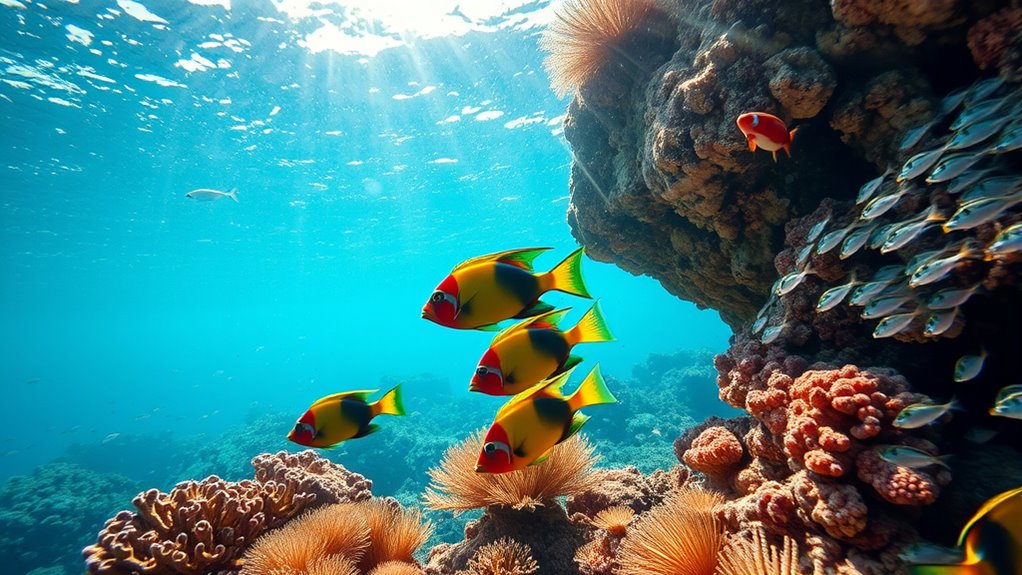
Sardinian waters host a rich diversity of marine life that varies throughout the year, offering dynamic encounters for divers and snorkelers alike. You might spot Loggerhead sea turtles, especially during warmer months when they come ashore to breed, though they’re increasingly threatened. Barracudas are present year-round, peaking in late spring through early autumn when waters are clearer and currents warm. Schooling fish like Damselfish and Salema Porgy spawn in spring and summer, creating vibrant shoals. Crabs and limpets are steady residents, thriving in nutrient-rich waters and rocky habitats. Cephalopods like octopus and cuttlefish are common, while starfish and gobies add to the underwater spectacle. Seasonal changes, such as blooming Posidonia meadows, support this rich tapestry of marine life. The presence of the Noble Pen Shell indicates healthy, unpolluted waters, which contributes to the overall biodiversity and enhances the diversity of species observed.
Underwater Features and Flora of Capo Testa
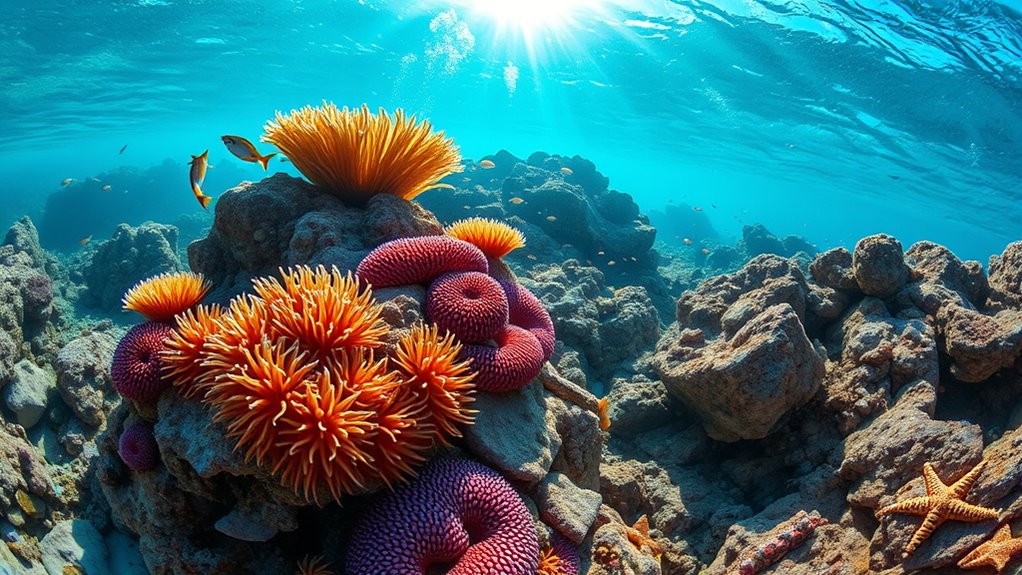
You’ll notice striking underwater features like ancient Roman columns and artifacts scattered along the seafloor, adding a touch of history beneath the waves. The area also boasts vibrant marine vegetation, including seaweed and coral, which create a lush habitat for marine life. These features and flora make Capo Testa a fascinating spot for exploring the underwater landscape. The waters are exceptionally clear, providing excellent visibility for snorkelers and divers to fully appreciate these natural and historic sights. Additionally, the presence of marine vegetation helps support diverse ecosystems, making the area even more intriguing for underwater exploration.
Roman Columns & Artifacts
Beneath the crystal-clear waters of Cala Spinosa at Capo Testa, ancient Roman columns lie submerged, offering a remarkable glimpse into Italy’s archaeological past. These granite remains, often rejected or unfinished from Roman quarrying, showcase impressive craftsmanship. As a diver or snorkeler, you’ll notice:
- Large granite columns carved from single pieces, some with tool marks and drilled holes indicative of ancient quarry techniques.
- Evidence of quarrying activity, including orthogonal cuts and loose granite chunks near water level.
- A rich underwater landscape where these relics coexist with vibrant marine life like eels, lobsters, and corals, enriching the archaeological experience. This site exemplifies the ancient engineering that shaped Italy’s historical infrastructure.
- The presence of these artifacts highlights the historical significance of the site, attracting divers interested in Italy’s ancient engineering and underwater heritage.
Access is challenging, requiring careful navigation, but the site’s historical significance makes it a must-see for diving enthusiasts interested in Italy’s ancient engineering and underwater heritage.
Vibrant Marine Vegetation
| Marine Flora | Key Features | Ecological Role |
|---|---|---|
| Gorgonia sea fans | Colorful, filter feeders | Habitat for small fish |
| Posidonia seagrass | Large underwater meadows | Carbon sinks, nurseries |
| Caulerpa seaweed | Bright green, fast-growing | Food source, habitat |
Natural Canyons and Lava Formations in Orosei Gulf
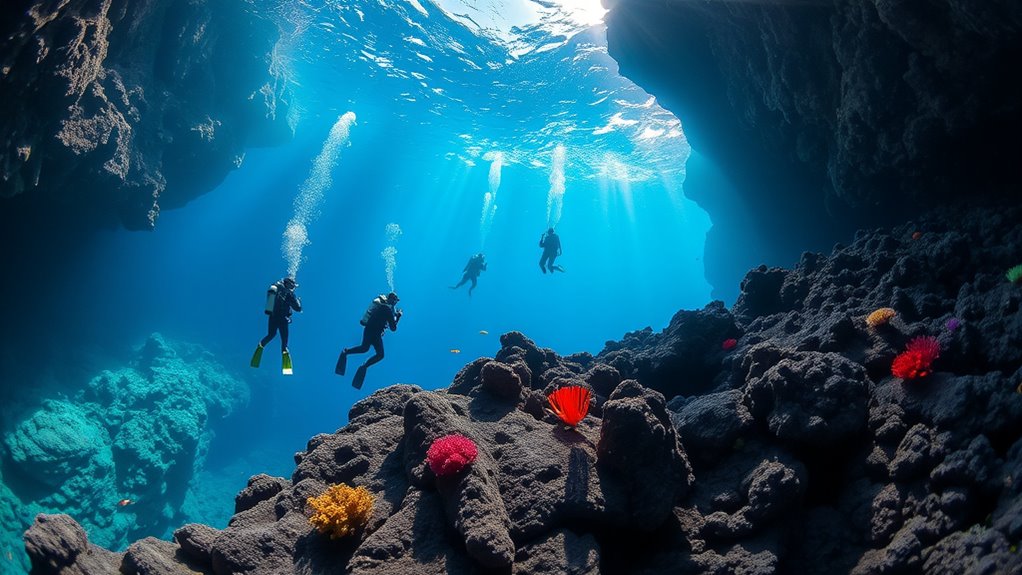
You’ll find volcanic lava slopes and rugged canyon ecosystems below the surface in the Gulf of Orosei, creating dramatic underwater landscapes. These formations host rich marine biodiversity, with colorful fish and unique species thriving amidst the rocks. Exploring these geological features offers a fascinating glimpse into Sardinia’s dynamic natural history. Sardinia’s canyons are also notable for their diverse shapes and sizes, providing a variety of underwater environments for explorers and researchers alike. Additionally, the underwater topography plays a crucial role in supporting a wide array of marine life, making these sites particularly valuable for scientific study.
Volcanic Lava Slopes
The volcanic lava slopes in the Orosei Gulf are striking remnants of ancient eruptions that sculpted Sardinia’s eastern coast. These slopes feature hardened lava flows forming rugged, textured underwater landscapes. You’ll encounter natural ridges, terraces, and undulating surfaces that resemble canyons below sea level. The geological history of these formations reveals a dynamic past of volcanic activity that continues to influence the region’s natural beauty today. There are three key highlights: 1. Complex Underwater Topography: Natural canyons and lava formations create diverse routes, with sharp ridges and smoother areas for exploration. 2. Rich Marine Life: Crevices and fissures host sponges, corals, and shelter small fish, crustaceans, and mollusks. 3. Clear Waters: Pristine visibility, often over 20 meters, reveals the intricate lava structures and vibrant marine ecosystems. The volcanic origin of these slopes adds a layer of geological significance to the diving experience, making it a unique, geologically fascinating diving experience, perfect for adventurous explorers.
Canyon Ecosystems Below
Beneath the waters of the Orosei Gulf, natural canyons and limestone formations create a dramatic underwater landscape shaped by millions of years of erosion. Fossil canyons like Codula Fuili, now dry, reveal deep limestone structures formed by ancient rain, resulting in wide caves, narrow tunnels, and turquoise inlets. These formations feature steep drop-offs ideal for experienced divers exploring underwater grottos and caverns. The canyon walls extend below sea level, creating complex ecosystems that shelter diverse marine life. Underwater tunnels and steep cliffs provide unique habitats, making these sites hotspots for underwater exploration. As you dive, you’ll encounter the rugged, karst limestone topography—an impressive legacy of geological forces that continues to shape the Gulf’s vibrant, mysterious canyon ecosystem. The underwater landscape is further enriched by the presence of diverse marine species that thrive within these complex formations, which are part of the broader karst landscape that influences the region’s geological history.
Rich Marine Biodiversity
The dramatic underwater landscapes of the Orosei Gulf, shaped by ancient limestone formations and volcanic activity, serve as rich habitats for a diverse array of marine life. These geological features create unique environments that support vibrant ecosystems. Subtopic 1: Cala Mariolu Overview The region’s varied underwater terrain, including limestone cliffs and caves, provides essential shelter and breeding grounds for many species. 1. Natural arches and caves: Cala Goloritzé’s towering limestone arch and caves like Grotta del Fico provide shelter for fish and invertebrates. 2. Lava and rocky seabeds: Submerged volcanic rocks and varied seabeds foster coral growth and attract species like groupers and small reef fish. 3. Protected habitats: Marine reserves safeguard these structures, ensuring healthy coral populations and abundant marine diversity, making this region a diver’s paradise.
Wreck Diving and Night Dives at Sardinian Shipwreck Sites
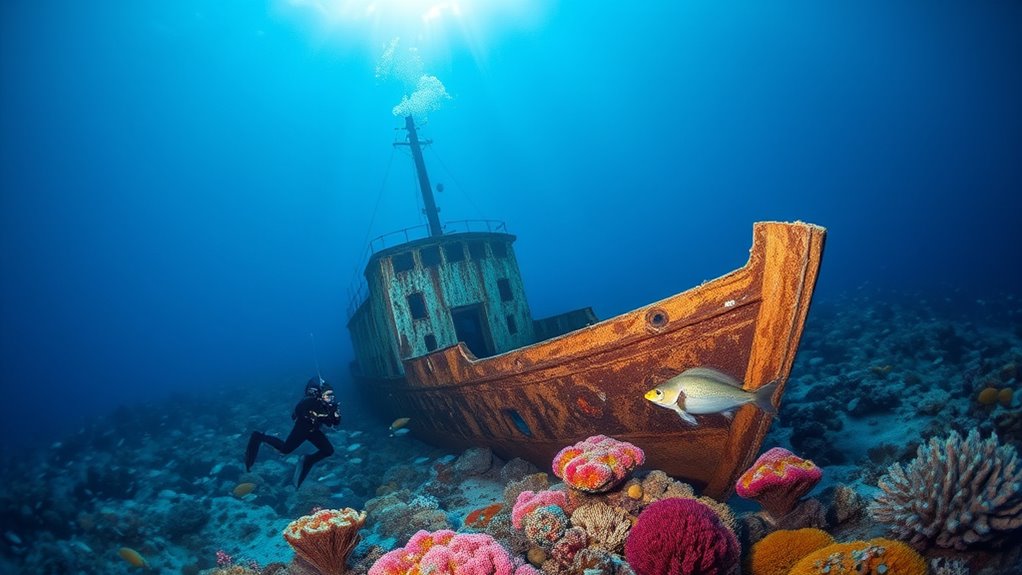
Exploring Sardinian shipwrecks offers an exciting combination of history and adventure, especially during night dives when the marine world reveals its nocturnal secrets. You can dive on ancient Roman wrecks near Porto Torres, where well-preserved amphorae and artifacts tell stories of bygone eras. Near Capo Testa, wrecks at shallow depths showcase their broken structures, perfect for exploring under artificial light, which enhances visibility and highlights archaeological details. The Nasello wreck in Orosei Gulf, a WWII German cargo ship, rests at about 110 feet, offering a more challenging night dive experience. As you navigate these sites in darkness, you’ll witness lobsters and eels emerging from caves, creating a surreal underwater spectacle. These wrecks, often surrounded by caves and volcanic formations, provide a unique blend of history, exploration, and nocturnal marine activity. Proper safety precautions are essential for night dives to ensure a secure and enjoyable experience.
The Rich Biodiversity of Sardinian Underwater Ecosystems
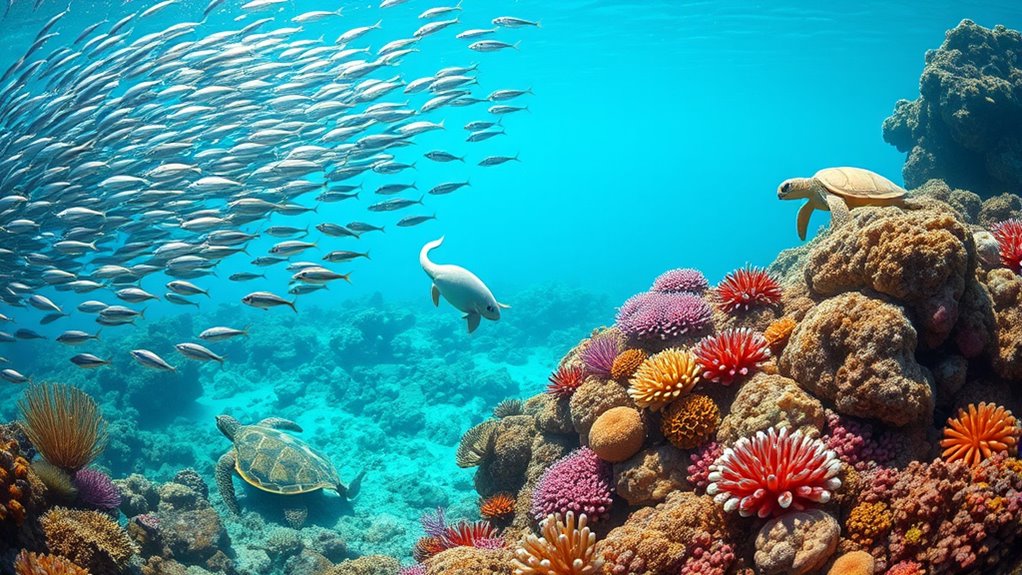
Sardinian waters host an astonishing diversity of marine life, making them one of the most vibrant ecosystems in the Mediterranean. As a diver, you’ll encounter over 17,000 documented species and unique endemics shaped by Sardinia’s geological history. The region also serves as essential migration corridors for whales, dolphins, and large pelagics. Here are three highlights:
- Rich habitats like rocky reefs, seagrass meadows, and deepwater canyons support a wide array of marine communities.
- Endemic species thrive in protected areas such as Capo Caccia and Isola Asinara, where biodiversity flourishes.
- Threatened giants like the Basking Shark feed in northeastern waters, emphasizing the importance of conservation efforts. The Mediterranean’s rich biodiversity is increasingly at risk from human activities and climate change, making conservation initiatives vital.
These ecosystems not only dazzle but also depend on ongoing protection and research.
Frequently Asked Questions
What Certifications Are Required for Diving in Sardinian Caves and Wrecks?
You need specific certifications to plunge into Sardinian caves and wrecks. For caves, an Advanced Open Water Diver certification is usually required, along with specialized courses like Cavern Diver or Full Cave Diver, which involve extensive theory and practical training. For wrecks, at least an Advanced Open Water certification is recommended, with technical wreck certifications for more complex dives. Prior experience, logged dives, and ongoing training are essential for safety and progression.
Are Diving Excursions Available Year-Round on Sardinian Islands?
Did you know that Sardinia’s waters stay suitable for diving almost all year, thanks to its Mediterranean climate? You can enjoy diving excursions year-round, though many dive centers close from November to April. During warmer months, expect vibrant marine life, clear visibility, and accessible sites like caves and wrecks. Even in winter, some centers operate, offering limited but rewarding dives, so you can explore Sardinian underwater wonders anytime.
What Are the Best Months to Observe Marine Species Like Sunfish or Dolphins?
The best months to spot marine species like sunfish and dolphins are during late spring and summer. From March to June, you have the highest chances of seeing elusive sunfish as water warms and plankton blooms. Dolphins are more active from June to October, especially in summer when waters reach around 26°C. Visiting in May or June gives you a great chance to see both species, with peak biodiversity from June to October.
How Accessible Are the Most Popular Dive Sites for Disabled or Limited-Mobility Divers?
You’ll find that many popular dive sites in Sardinia are quite accessible for disabled or limited-mobility divers. Some centers offer specialized training, adaptive guides, and equipment, making dives safer and more comfortable. Sheltered spots around islands like Maddalena and Villasimius provide calmer waters, ideal for you. However, boarding boats and steering certain rugged sites might pose challenges, so it’s best to check with local centers beforehand to make sure your needs are met.
What Safety Precautions Should Divers Take When Exploring Underwater Caves and Wrecks?
Think of exploring underwater caves and wrecks as steering through a delicate labyrinth, where safety is your guiding thread. You should thoroughly check your equipment, use a reel as your lifeline, and plan your dive meticulously. Stay calm during emergencies, communicate clearly with your buddy, and follow established protocols. By respecting the environment and preparing for the unexpected, you guarantee your journey remains safe and rewarding beneath the waves.
Conclusion
As you immerse yourself in Sardinia’s crystal-clear waters, you’ll uncover a vibrant underwater tapestry teeming with life and history. Each site is like a hidden treasure chest waiting to be opened, revealing breathtaking caves, colorful marine life, and centuries-old wrecks. Whether you’re a beginner or an expert, Sardinia’s diverse dive spots invite you to explore a submerged wonderland that’s as enthralling as a painter’s palette, leaving you with memories as deep as the ocean itself.
